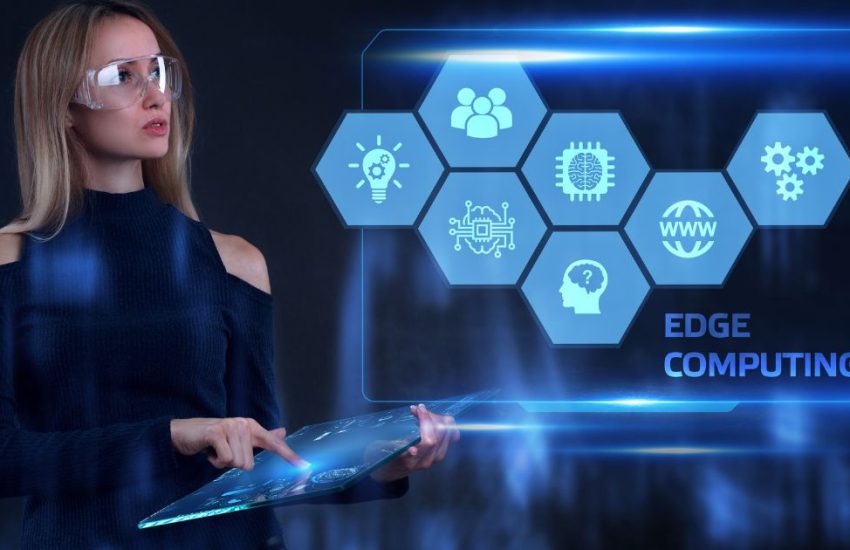How does edge vs cloud computing fare when you compare them head-to-head? Continue reading this comparative guide to know in detail.
You must have heard of the terms edge computing and cloud computing if you are interested in technological innovations. However, just knowing about these computing models is not enough if you want to implement them in your business. You should have detailed knowledge about these and how they are different from each other.
To help you with that, I bring you this article where I will discuss the differences, along with the importance, working process, pros, cons, and use cases of these models.
What Is Edge Computing?
Edge computing is a decentralized data processing approach that takes place near the source of data. This computing model improves efficiency as the task is performed locally on devices. It optimizes the performance of IoT applications and real-time analytics. Other highlighted features of this computing are reduced latency and less bandwidth usage.
Also read: What Is Edge Computing and What Are Its Applications?
Importance of Edge Computing
At the present time, edge computing bears the utmost importance by decreasing the time taken for data transfer. With its help, applications used in IoT, healthcare, and manufacturing can process data in real-time.
For example, sectors like autonomous vehicles require quick response time for data processing. Edge computing can provide reliable data analysis while conserving bandwidth.
So, the importance of edge computing lies in its ability to improve connectivity and computing for emerging technologies, like IoT. It also makes these applications more robust and responsive to help them keep pace with the evolving computing of the present generation.
Since edge computing can handle data efficiently on the edge, it results in reduced congestion in the cloud. This system ultimately enhances overall system performance, driving advancements in the fields of technology and connectivity.
How Does Edge Computing Work?




Edge computing contributes to efficient and responsive systems for various industries through optimized data processing. As mentioned already, edge computing processes the data near its data source instead of relying on centralized servers located in the cloud.
Devices like IoT devices or sensors that are situated at the network edge collect data locally and perform initial processing.
As this reduces the necessity to send all the collected data to a cloud server for analysis, there will be reduced latency and bandwidth usage. After the processing, the data is sent to the cloud either for storage or further analysis. Hence, you can expect a quicker response time and real-time applications of data.
Pros of Edge Computing
- Reduced latency during data processing
- Support for real-time processing
- Less dependency on centralized servers
- Ideal for IoT, healthcare applications
- Suitable for data processing with slow internet connectivity
- Conservation of bandwidth in areas where the internet is not easily available
- Increased reliability for critical sectors
- Suitable for emerging and latest technologies
Cons of Edge Computing
- Limited storage capability of edge devices
- Does not have processing power for large amounts of data processing
- High expenses for initial deployment and maintenance
- Complex and difficult-to-manage distributed infrastructure
- Certain edge environments have limited scalability
- Decentralized locations often come with potential security concerns
- Difficulties in maintaining standardization across edge nodes
What Is Cloud Computing?
In cloud computing, the resources are located in the remote or cloud server. Users can access the resources using the internet and use them for data processing, data storage, and many more.
With this approach, users can leverage the cloud-based infrastructure and applications. As these can be accessed through the internet, there is no need to install and maintain their on-premise versions.
Importance of Cloud Computing
Cloud computing has changed how individuals and businesses process, access, and store data. It ensures improved accessibility as one can access data and applications from anywhere with an internet connection. This computing model is also highly scalable and enables users to increase or decrease the use of resources.
This model offers pay-as-you-use pricing that helps you access services at an affordable cost. Moreover, it does not involve any upfront infrastructure investments. Thus, SMBs can use this service without breaking the bank.
Real-time data sharing is possible on cloud computing, which allows users to collaborate. Also, it functions as a platform for emerging technologies like AI and IoT.
How Does Cloud Computing Work?
In cloud computing, users can access various computing resources by utilizing the internet. When someone opts for cloud computing, they do not have to depend on PCs or local servers. Instead, they can store data and run applications hosted in cloud-based data centers.
These servers are capable of processing data, storing information, and running applications — all with the help of the Internet. When a user requests a service or uploads data, the cloud servers manage these operations.
Data centers that manage these servers make sure that the servers work seamlessly with necessary hardware and software.
Cloud computing offers several service models, such as IaaS, SaaS, and PaaS, to serve different purposes. For example, SaaS lets you access software applications using the internet, IaaS provides virtualized computing resources, and PaaS offers a platform for developing and running applications without any on-premise infrastructure.
Pros of Cloud Computing
- Remote data access from any location with internet connectivity
- Real-time data sharing and communication with stakeholders
- Enhanced collaboration among the teammates for processed data
- Streamlined control and security for data processing and storage
- Centralized data management to protect data from hackers
- The use of shared resources allows for reduced energy consumption
- Scalability to adjust varying workloads
Cons of Cloud Computing
- Internet dependency could lead to potential downtime
- Possible security concerns regarding cloud data breaches
- Limited customization and control over cloud servers
- Dependency on third-party service providers leads to data privacy concerns
- Service outages can affect multiple users for an uncertain amount of time
- Performance predictability is not possible in a shared cloud environment
- Compliance and legal issues could be challenging to manage
Also read: Distributed Cloud Computing Explained in 5 Minutes or Less
Edge vs. Cloud Computing
| Features | Edge Computing | Cloud Computing |
| Architecture | Consist of distributed architecture | Consist of distributed architecture |
| Performance | Offers high performance for localized tasks | Offers scalable performance for complex workloads |
| Latency | Low latency due to processing data closer to the source | Higher latency as the data is processed in remote cloud servers |
| Security | Localized data processing ensures high security | Centralized security measures are implemented in data centers |
| Scalability | Limited scalability for limited local devices | High scalability due to on-demand resource allocation |
| Data Storage | Limited storage capacity on edge devices | Scalable storage capacity in centralized servers |
| Flexibility | Suitable for specific uses and environments | Flexible resource allocation for diverse use cases |
| Dependency | Reduced dependency on internet connectivity | Depends heavily on robust network connectivity |
| Deployment | Ideal for remote or resource-constrained areas | Ideal for areas with stable and high-speed internet access |
| Management | Decentralized management of edge devices | Centralized management of resources and services |
| Redundancy | Redundancy is done through devices and distributed processing | Data backup is done on central servers |
| Innovation | Innovation is supported at the edge or device level | Deployment of innovative applications and services is supported |
| Compliance | Compliance has to be ensured locally | Compliance and regulatory adherence are done from the central infrastructure |
| Cost | Locally cost-effective option due to lower data transfer cost | Despite higher data transfer costs, use-based pricing could make it an affordable option |
How To Use Edge and Cloud Computing Together
From the above discussion, you can see that edge computing and cloud computing are fundamentally different types of approaches or architectures. This might make you think that these two approaches do not work together. However, that is not the case. You can, in fact, use edge and cloud computing for your business.
For example, using both cloud and edge simultaneously makes sense in cases when you let the cloud servers process complex workloads and use edge infrastructure to handle processes that need reduced latency.
With a combined use of these two technologies, organizations can achieve multiple objectives. Cloud environments let them attain scalability and ease of deployment, while edge computing enables them to achieve high-performance goals. Find below some sectors where you can use both together:
- For efficient data processing, you can use edge computing initially for quick insight extraction and use cloud computing to conduct more in-depth analysis.
- To ensure reliable service, edge computing distributes critical tasks across edge devices, while cloud computing makes the data available when the edge devices fail.
- When it comes to security and compliance, edge computing ensures that by locally processing sensitive data, cloud computing offers robust security measures and compliance frameworks.
- For cost optimization, businesses can use edge computing to minimize data transfer costs and use cloud computing for usage-based services.
All-in-all, businesses can strategically use edge and cloud computing together to create a holistic and efficient infrastructure for optimal data processing.
Use Cases of Edge Computing
Autonomous Vehicles
An autonomous vehicle (AV) needs to make instant decisions as it does not have a human controlling it. Hence, these vehicles have to use edge computing for quick decision-making and interacting more efficiently among themselves.
Healthcare
Health monitors and wearable healthcare devices work to keep a constant eye on the status of a patient. Here, edge computing plays a critical role by processing the data instantly, enabling the devices to instantly alert the caregivers about a critical condition.
Video Surveillance




The use of edge computing is key for video surveillance and security. When a camera records live events, edge computing allows it to instantly identify any possible threats. Sending the data from the smart camera to remote servers would have taken a lot of time, leading to security threats.
Sustainable Technology
To make cities use sustainable technology adoption of edge computing is essential. This computing model allows devices to monitor efficient usage of heating, lighting, and clean energy.
Smart Cities
Smart cities consist of a variety of IoT devices for enhanced operation. Many interconnected devices and infrastructures work together to ensure proper functioning. These call for the use of edge computing for the synchronized functioning of these devices.
Use Cases of Cloud Computing
Software as a Service (SaaS)
The most common use case of the cloud is web-based software. It allows users to access software from anywhere without needing to download and install it on their device. The use of SaaS is seen among both individual and business users.
Software Development
When it comes to developing software by a remote or distributed team, nothing works better than a cloud-based PaaS. Here, flexible development infrastructures and resources are located in the cloud that anyone can access through the internet for collaborating software creation and testing.
Video Streaming




Platforms that stream on-demand online videos use cloud computing. They’re all based entirely on the development of cloud computing technology. This technology spares the service providers from buying expensive hardware and software and lets them have the online video content always ready for broadcast.
Data Backup
The cloud has become a reliable platform for data backup. Compared to the traditional data backup methods, this allows more security against hackers and different cyberattacks.
File Hosting
Cloud computing is also used for online data and file storage. From Google Drive to Dropbox, all the popular file storage platforms use cloud computing technology. It helps users to store the files on a cloud server and allow them to download the files when needed.
Conclusion
Now that you know the benefits of using edge computing and cloud computing, it is high time you started to use it in your business. You can use it separately or together, depending on your requirements.
If you want, check out our other articles on related topics, such as edge AI, and hybrid cloud computing.
Si quiere puede hacernos una donación por el trabajo que hacemos, lo apreciaremos mucho.
Direcciones de Billetera:
- BTC: 14xsuQRtT3Abek4zgDWZxJXs9VRdwxyPUS
- USDT: TQmV9FyrcpeaZMro3M1yeEHnNjv7xKZDNe
- BNB: 0x2fdb9034507b6d505d351a6f59d877040d0edb0f
- DOGE: D5SZesmFQGYVkE5trYYLF8hNPBgXgYcmrx
También puede seguirnos en nuestras Redes sociales para mantenerse al tanto de los últimos post de la web:
- Telegram
Disclaimer: En Cryptoshitcompra.com no nos hacemos responsables de ninguna inversión de ningún visitante, nosotros simplemente damos información sobre Tokens, juegos NFT y criptomonedas, no recomendamos inversiones


